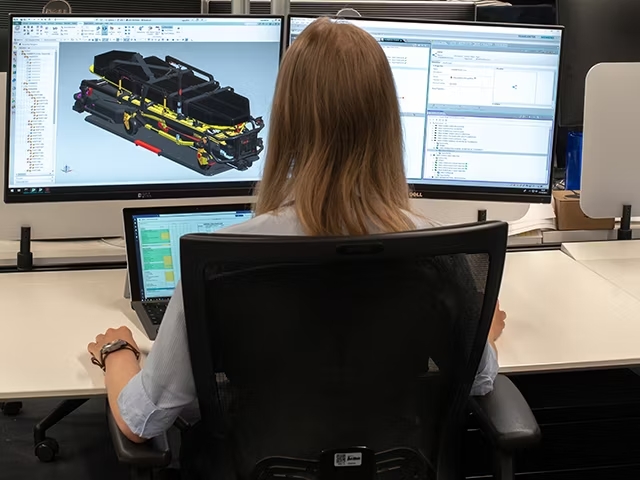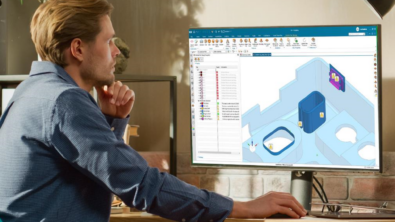What are Siemens PLM Components? | Software openness strategy

Welcome to another recap of the Next Generation Design podcast for the episode: From Concept to Creation: The Importance of Openness in Siemens Software. You can watch the full video version of the episode below.
On this episode of the Next Generation Design podcast, our host Greg Arnot speaks with Jon Rimmer and Graeme McBean from Siemens Digital Industries Software about the critical role of openness in software development. They discuss Siemens’ unique licensing strategy, which encourages collaboration with competitors, creating an open ecosystem that supports seamless integration across platforms.
Jon and Graeme dive into Siemens’ initiatives that foster this openness, including the Code of PLM Openness, and explore how PLM Components like Parasolid and JT facilitate data interoperability and cross-platform collaboration. By examining Siemens’ approach to “coopetition,” they explain how licensing software to competitors can be crucial to ensuring customer success.
Whether you’re interested in the future of open software in the digital industries or curious about Siemens’ innovative business strategy, this episode provides a fascinating look into a new model of software development.
Listen to the audio-only or read the transcript: From Concept to Creation: The Importance of Openness in Siemens Software.
What you’ll learn in this episode:
Why is software openness important?
The episode kicks off with discussing what “openness” really means in the context of software. Jon notes that there are three categories that we address here at Siemens Digital Industries Software.
- Open data: Allowing customers to transfer 3D product data seamlessly between different systems, minimizing data loss and corruption
- Open applications: Allowing customers to customize and extend software to meet specific business needs, ensuring flexibility in operations
- Open community: Having a robust network of partners to support customers in software implementation, integration, training, sales services, etc.; a strong user community to discuss challenges together; and communities of software vendor competitors to address customer needs (he calls this “co-opetition”)
Jon emphasizes that an open strategy helps to ensure customer success. Engineering is becoming more and more digital. With everything in the digital world, there are applications from different software vendors being used across the supply chain. Integrating software applications can cost customers millions or even up to tens of millions of dollars a year. With an open software strategy, we can ensure that data can move across disparate applications as efficiently as possible, enabling end-to-end digitalization while reducing costs and time to market.
Siemens’ commitment to Openness and the Code of PLM Openness
We get more background on openness with the Code of PLM Openness (CPO). Siemens has been at the forefront of promoting software openness through initiatives like the CPO, of which we are a founding partner alongside some of our competitors. This initiative, established around 15 years ago, was driven by the needs of major automotive manufacturers in Germany, such as BMW and Daimler, who sought clarity on what openness means in software. It brings together both software vendors and manufacturers to discuss openness. The CPO documentation currently identifies seven key areas with criteria for being an “open” vendor: interoperability, extensibility, standards, infrastructure, interfaces, architecture and partnerships.
The CPO initiative grows and evolves with time. This evolution included the introduction of a certification for openness, which the NX organization at Siemens Digital Industries Software passed in the pilot. Now that the pilot is complete, the CPO initiative is working on making the certification more robust.
How does NX software embrace openness to support customer access?
Jon notes that one way that the NX team at Siemens embodies the commitment to openness is by prioritizing customer choice in IT infrastructure. There are multiple ways you can deploy, adapt and scale NX based on your needs. We offer traditional desktop on-premises deployment of NX, cloud-managed SaaS with NX X, or you can even stream NX through a browser (as an add-on to NX X).
He also mentions NX Open, which equips customers and partners with programming tools and APIs to customize the software according to specific business needs. This could involve creating automation tools for repetitive tasks or modifying the user interface to align with industry-specific workflows.
Jon and Greg then discuss data interoperability. NX supports compatibility with legacy data, allowing users to read and modify parts created in earlier versions of the software, dating back to the mid-80s with Unigraphics. This ensures that users across different sites and companies can work seamlessly, regardless of the software version. Moreover, NX actively supports various internationally recognized data formats (eg. STEP, JT, 3MF, etc.), facilitating reliable data transfer across applications. Siemens also contributes to the evolution of these standards by participating in international committees, ensuring that they remain relevant and effective for their customer base. This commitment to openness not only enhances user experience but also fosters a collaborative environment within the industry.
How does openness help with the digital thread and digital twin?
Jon explains that a digital thread is a subset of the broader digitalization process, facilitating the flow of information across various stages of product development. It ensures that all stakeholders—designers, engineers, executives, and marketers—have access to the necessary data at every step.
So by supporting openness, NX software integrates seamlessly into these digital threads, enhancing collaboration and data accessibility. This interconnectedness allows for a more streamlined approach to managing product lifecycles, ultimately improving efficiency and decision-making.
What are Siemens’ SDKs: PLM Components
With the background and concept of openness addressed, Greg dives deeper into the actual software development toolkits (SDKs) that the Open Tools team offers, which are called PLM Components. Graeme explains that PLM Components are “products which have an API rather than a UI.” He gives a quick summary of each:
- Parasolid: A geometric modeling kernel (the most well-known PLM Component from Siemens)
- D-Cubed: Provides geometric constraints for 2D and 3D applications
- Kineo: Used for path planning and motion simulation, particularly in robotics
- Geolus: A search engine for geometric shapes
- JT: An file format primarily used for visualization and collaboration.
These components are embedded in Siemens applications such as NX, Solid Edge, Simcenter and more, which greatly enhances the quality of our products and compatibility between the different applications. But not only are they just found within our own software, we also sell them externally to anyone who would like to buy them, even our biggest competitors. Graeme mentions the “level playing field policy” that we follow to sell these components, which ensures that all customers receive the software at the same time. He emphasizes how unique it is for Siemens to not only use our components internally but also sell them, as other companies may do one but not the other.
Siemens PLM Components customers
Siemens has over 400 customers leveraging PLM components, which power thousands of applications. Notable users include our own competitors such as SolidWorks, Ansys, PTC, Onshape, and Autodesk. Our PLM Components are crucial to developing their applications. Graeme says, “We estimate that every day there’s more than 10 million engineers sitting down using applications that are powered by our Siemens components.”
What is Parasolid from Siemens?
Greg then asks about Parasolid and JT in more detail, as they are crucial to NX. Parasolid is the biggest PLM Component and the oldest, being released in 1989. Parasolid is a geometric modeling kernel, so it is the “geometry engine that sits in the middle of any application, primarily the CAD applications, that defines the shape that you’re modeling through the creation of the shapes, the editing of the shapes, and then asking questions of the shapes, the inquiries and analysis of those in order to drive our manufacturing and simulation software.”
The XT file format, associated with Parasolid, allows for seamless data exchange between different CAD systems without translation errors, ensuring reliability and efficiency. This interoperability is a major selling point, as many organizations license Parasolid not just for modeling but also for its ability to facilitate data movement across thousands of applications.
What is JT from Siemens?
Graeme says that “JT is key to our openness strategy these days.” JT, originally a visualization format, has evolved to facilitate both visualization and collaboration across various industries. JT files can contain multiple different types of data, including geometric data (ie. Parasolid XT), product manufacturing information and metadata, all organized in different containers for flexibility.
The JT Open Program, initiated in response to requests from major customers like GM and Daimler, aims to promote the use of JT across the industry. This initiative has been highly successful, with over 100 companies collaborating to increase its usage as well as enhance the format’s capabilities and interoperability. JT has also been recognized as an ISO standard, providing enterprise customers with confidence in its long-term viability for data storage and archival purposes. With the wide usage of JT, we also offer a free JT and Parasolid XT file viewer called JT2Go in addition to the JT Open Toolkit.
Graeme mentions that the Open Tools team recently looked at the number of files being created. They were already to 100 million JT files from just eight corporate customers.
The podcast concludes with future visions for Siemens in software openness, and Jon reinforcing Graeme’s comment about the adoption of Parasolid across Siemens Xcelerator, with its presence in applications throughout design, simulation and manufacturing ensuring seamless data interoperability and compatibility across our products.
Want to learn more about PLM Components? Check out the website or explore trial options.
Continue listening to the Next Generation Design podcast.
Want to learn more about NX CAD software? Check out our website or try it for free.


